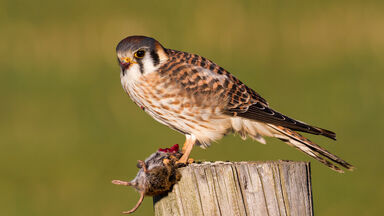Other species of wandering habits carry the cocoon about with them, sometimes attached to the spinnerets, as in the Lycosidae, sometimes tucked under the thorax, as in the large tropical house-spider, Heteropoda regia, one of the Clubionidae.
The nature of the integument and its hairy clothing in all spiders enables them to be plunged under water and withdrawn perfectly dry, and many species, even as large as the common English house-spider (Tegenaria), are so lightly built that they can run with speed over the surface of standing water, and this faculty has been perfected in genera like Pirata, Dolomedes and Triclaria, which are always found in the vicinity of lakes or on the edges of rivers and streams, readily taking to the water or running down the stems of water plants beneath its surface when pursued.
The larger species of Bird's Nest Spiders (Avicularia), the opisthosoma of which is as large as a bantam's egg, undoubtedly attack young birds, and M'Cook gives an account of the capture in its web by an ordinary house spider of a small mouse.





